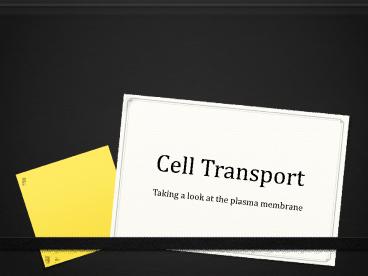Cell Transport - PowerPoint PPT Presentation
Title:
Cell Transport
Description:
Cell Transport Taking a look at the plasma membrane The Cell Membrane His friends call him the plasma membrane He is thin and flexible He has two main ... – PowerPoint PPT presentation
Number of Views:68
Avg rating:3.0/5.0
Title: Cell Transport
1
Cell Transport
- Taking a look at the plasma membrane
2
The Cell Membrane
- His friends call him the plasma membrane
- He is thin and flexible
- He has two main functions
- Protection protects the cell from the outside
environment - Regulation controls what can enter and exit the
cell - He is selective allows some things to pass
through more easily than others - He is selectively permeable permeate is a fancy
way to say pass through.
3
What is the Fluid-Mosaic Model?
- Whats a mosaic?
- What does it mean to be fluid?
- The cell membrane is NOT a rigid structure with
immovable components! - The cell membrane is fluid-like and flexible
- Within the membrane, molecules can move around
4
What Is the Cell Membrane Made of?
5
The (Phospho-)Lipid Bilayer
- LIPIDS Phospholipids make up the majority of the
cell membrane - Hydrophilic heads (polar) are made of phosphates
(Phospho) - Hydrophobic tails (nonpolar) made out of fatty
acids (Lipid) - To protect the hydroPHOBIC
- tails from water, they form a
- bilayer which keeps the tails
- inside and the water- loving
- heads outside.
6
More Parts of the Cell Membrane
- Also embedded in the lipid bilayer are proteins
and carbohydrate chains - Protein molecules bring materials into the cell
and receive signals from outside the cell - Carbohydrate molecules (attached to proteins or
lipids) have antenna to help cells identify or
recognize other cells
YouTube Membrane
7
Draw the Cell Membrane!
8
Your turn!
- Use your notes and what youve learned so far to
complete the matching exercise in your notes - Protein (only) B
- Carbohydrate (only) D
- Lipid Bilayer A
- Phosphate Head F
- Fatty Acid Tail G
- Involved in Cell Recognition D
- Carbohydrate attached to a lipid E
- Helps move large material across the membrane B
- Carbohydrate attached to a protein C
- Outside cell H
9
Solutions
- Molecules dissolved in a liquid SOLUTES
- Liquid/fluid dissolving them SOLVENT
- This makes a SOLUTION
- In a salt solution, ______________ is the solute
and _____________ is the solvent - In a sugar solution, sugar is the solute and
water - is the solvent.
-
-
Dots solute -
Space solvent
SALT
WATER
10
Concentration and Equilibrium
- Solutions will spread out their dissolved
molecules until they are equal throughout. - EQUILIBRIUM molecules are spread equally
- CONCENTRATION of molecules in an area per
unit volume.
?High concentration more solutes per
unit volume Low concentration less
solutes ? per unit volume
11
What happens with a barrier?(like a cell
membrane)
- If solutions on either side of the barrier have
the same concentration, they are at equilibrium.
- At equilibrium, both the solvent and solute move
back and forth across the barrier there is
always movement.
12
Transport of Materials Across the Cell Barrier
- Materials move across the plasma
- membrane in two ways
- Passive Transport
- movement across the membrane
- without using energy
- Active Transport
- movement across membrane
- that requires energy
13
Types of Passive Transport 1. Diffusion
- Solutes move across a membrane from areas of high
concentration (crowded) to low concentration
- Diffusion random particle movements, so does
not use energy.
Imagine warm air coming through an open window
14
Types of Passive Transport 2. Osmosis
- A special name for diffusion of water!
- Water molecules (fast and small) pass through the
cells selectively permeable membrane - Solute molecules are too large to pass -- only
the water diffuses until equilibrium is reached.
15
(No Transcript)
16
Types of Passive Transport 3. Facilitated
Diffusion
- Large molecules or those with a charge need the
help of a protein to pass across a cell membrane - Proteins form a channel
and molecules move through the doorway. Each
channel is specific to a particular type of
molecule Doesnt require energy gt passive
transport
17
(No Transcript)
18
Active Transport
- Movement AGAINST the concentration gradient
requires energy (because it moves solutes from
low to high concentrationwhere its already
crowded) - Difference in solution concentrations
concentration gradient - Three types of active
transport
19
Active Transport1. Pump
- Pump a protein PUSHES molecules across the
membrane
Ex the Sodium and Potassium (Na/K) Pump.
YouTube Na/K Pump
20
Active Transport2. Endocytosis
- Endocytosis (endoin) a pocket (vacuole) forms
around a large molecule outside the cell and buds
inward to release the material inside the cell.
21
(No Transcript)
22
Active Transport3. Exocytosis
- Exocytosis (exoout) a vacuole inside the cell
fuses with the cell membrane and forces the
material outside the cell.
23
Animation































